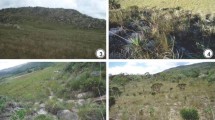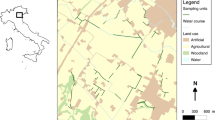Abstract
The present study was designed to investigate the relative importance of biotic versus abiotic factors in determining the distribution of species among heterogeneous environments. The composition of 70 quadrats of 0.25-m2, located in a 13-m × 40-m region of a mown field in Durham, North Carolina, was defined through two sets of principal component scores representing soil and vegetation gradients in the study area. The first principal component in each of the analyses exhibited a monotonic increase in value along an elevational gradient characterizing the field. This represents a one-dimensional correlation structure between the background soil and vegetation variables. Secondary soil and vegetation gradients, represented by the remaining principal component axes, were for the most part uncorrelated.
Regression analyses were used to study the relationships coupling the distribution of Danthonia sericea, a bunchgrass species, to the distribution of associated soil and vegetation gradients. The correlation of the distribution of Danthonia to the dominant soil/vegetation gradient was highly significant. In addition, strong, secondary correlations with the background vegetation remained after removal of variance associated with soil composition; the converse was, in general, not true. One exception involved a minor zinc gradient that exhibited a negative correlation with the distribution of Danthonia. A strong correlation was found coupling an interaction term associated with the primary soil/vegetation gradient to the distribution of Danthonia. The results suggest that the present distribution of Danthonia is modified to a large extent by competitive interactions with other plant species. However, the relative significance of the soil-by-vegetation interaction term also indicates that soil composition must be explicitly considered to properly understand the role of biotic interactions. Any one factor, biotic or abiotic, may modify the distribution of a species, but the way in which it modifies the distribution will depend directly upon the composition of the other factors making up the biotic and abiotic, environmental background.
Similar content being viewed by others
Abbreviations
- Danthonia =:
-
the species Danthonia sericea
- PC =:
-
principal component
- PCA =:
-
principal component analysis
- SS =:
-
sum of squares
References
Antonovics J. 1976. The input from population genetics: ‘The new ecological genetics’. Syst. Bot. 1: 233–245.
Austin M.P. 1976. On non-linear species response models in ordination. Vegetatio 33: 33–41.
Austin M.P. 1980. Searching for a model for use in vegetation analysis. Vegetatio 42: 11–21.
Austin M.P. & Austin B.O. 1980. Behavior of experimental plant communities along a nutrient gradient. J. Ecol. 68: 891–918.
Caswell H. & Werner P. 1978. Transient behavior and life-history analysis of teasel Dipsacus sylvestris Huds. Ecology 59: 53–66.
Clay K. 1982. Environmental and genetic determinants of cleistogamy in a natural population of the grass Danthonia spicata. Evolution 36: 734–741.
Clay K. & Levin D.A. 1986. Environment-dependent intraspecific competition in Phlox drummondii. Ecology 76: 37–45.
Clements F.E. 1936. Nature and structure of the climax. J. Ecol. 24: 252–284.
Connor E. & Simberloff D. 1978. Species number and compositional similarity of the Galapagos flora and avifauna. Ecol. Monogr. 48: 219–248.
Connor E. & Simberloff D. 1979. The assembly of species communities, chance or competition? Ecology 60: 1132–1140.
Connor E. & Simberloff D. 1984. Neutral models of species' co-occurrence patterns. In: StrongJr D.R. Simberloff D. Abele L.G. & Thistle A.B. (eds), Ecological communities: conceptual issues and the evidence. pp. 316–331. Princeton University Press, Princeton, NJ.
Diamond J. 1978. Niche shifts and the rediscovery of interspecific competition. Am. Sci. 66: 322–331.
Diamond J. & Gilpin M. 1982. Examination of the null model of Connor and Simberloff for species co-occurrences on islands. Oecologia 52: 64–74.
Fowler, N.L. 1978. Competition and coexistence in a herbaccous plant community. Ph.D. Diss., Duke University, Durham, NC.
Fowler N.L. & Antonovics J. 1981. Competition and coexistence in a North America grassland. I. Patterns in undisturbed vegetation. J. Ecol. 69: 825–841.
Gauch H.G. 1982. Multivariate analysis in community ecology. Cambridge University Press, Cambridge.
Gilpin M.E. & Diamond J.M. 1984. Are species co-occurrences on islands non-random, and are null hypotheses useful in community ecology. In: StrongJr D.R. Simberloff D. Abele L.G. & Thistle A.B. (eds), Ecological communities: conceptual issues and the evidence. pp. 297–315. Princeton University Press, Princeton, NJ.
Gittins R. 1985. Canonical analysis, a review with applications in ecology. Springer, Berlin.
Gleason H.A. 1926. The individualistic concept of the plant association. Bull. Torrey Bot. Club 53: 7–26.
Goodnight J.H. 1978. Tests of hypotheses in fixed effects linear models. SAS Technical Report R-101. SAS Institute, Raleigh, NC.
Hastings A. 1987. Can competition be detected using species co-occurrence data? Ecology 68: 117–123.
Heywood J.S. & Levin D.A. 1984. Genotype-environment interactions in determining fitness in dense, artificial populations of Phlox drummondii. Oecologia 61: 363–371.
Hughes T. & Jackson J. 1985. Population dynamics and life histories of foliaceous corals. Ecol. Monogr. 55: 141–166.
Keddy P.A. 1987. Beyond reductionism and scholasticism in plant community ecology. Vegetatio 69: 209–211.
Kullman C. 1986. Growth of Betula pubescens ssp. tortuosa sown in contrasting habitats close to the birch tree-limit in Central Sweden. Vegetatio 65: 13–20.
Loveless M. & Hamrick J. 1984. Ecological determinants of genetic structure in plant populations. Ann. Rev. Ecol. Syst. 15: 65–95.
Lowther J.R. 1980. Use of a single sulfuric acid-hydrogen peroxide digest for the analysis of Pinus radiata needles. Comm. Soil. Sci. Pl. Anal. 11:: 175–188.
McIntosh R.P. 1967. The continuum concept of vegetation. Bot. Rev. 33: 130–187.
McNeilly J. & Antonovics J. 1968. Evolution in closely adjacent populations. IV. Barriers to gene flow. Heredity 23: 205–218.
Moloney K.A. 1986a. A generalized algorithm for determining category size. Oecologia 69: 176–180.
Moloney, K.A. 1986b. Determinants of species distributions. Danthonia sericea as a model system. Ph.D. Diss. Duke University, Durham, NC.
Moloney K.A. 1988. Fine-scale spatial and temporal variation in the demography of a perennial bunchgrass. Ecology 69: 1588–1598.
Morin P. 1983. Predation, competition, and the composition of larval anuran guilds. Ecol. Monogr. 53: 119–138.
Morrison D.F. 1976. Multivariate statistical methods. McGraw-Hill, NY.
Neilson R.P. 1987. Biotic regionalization and climatic controls in western North America. Vegetatio 70: 135–147.
Neilson R.P. & Wullstein L.H. 1983. Biogeography of two Southwest American oaks in relation to atmospheric dynamics. J. Biogeogr. 10: 275–297.
Noy-Meir L. & van der Maarel E. 1987. Relations between community theory and community analysis in vegetation science: some historical perspectives. Vegetatio 69: 5–15.
Roughgarden J. 1983. Competition and theory in community ecology. Am. Nat. 122: 583–601.
Sale P. 1982. Stock-recruit relationships and regional coexistence in a lottery competitive system, a simulation study. Am. Nat. 120: 139–159.
Sale P. & Williams D. 1982. Community structure of coral reef fishes, are the patterns more than those expected by chance? Am. Nat. 120: 121–127.
Sano Y., Sano R. & Morishma H. 1984. Neighbor effects between two co-occurring rice species, Oryza sativa and O. glaberrima. J. Appl. Ecol. 21: 245–254.
SAS Institute, Inc. 1982. SAS user's guide, statistics. 1982 ed. SAS Institute, Cary, NC.
Schoener T. 1982. The controversy over interspecific competition, is the competitionists view a failed paradigm? American Scientist 70: 586–595.
Shipley B. & P.A. Keddy. 1987. The individualistic and community-unit concepts as falsifiable hypotheses. Vegetatio 69: 47–55.
Shmida A. & Ellner S. 1984. Coexistence of plant species with similar niches. Vegetatio 58: 29–55.
Silvertown J. & Wilkin F. 1983. An experimental test of the role of micro-spatial heterogeneity in the co-existence of congeneric plants. Biol. J. Linnean Soc. 19: 1–8.
Snaydon A. & Davies M. 1972. Rapid population differentiation in a mosaic environment. II. Morphological variation in Anthoxanthum odoratum. Evolution 26: 390–405.
Sokal R.R. & Rohlf F.J. 1981. Biometry. 2nd ed. W.H. Freeman, San Francisco, CA.
Tilman D. 1982. Resource competition and community structure. Princeton University Press, Princeton, NY.
Turkington R. & Harper J. 1979. The growth, distribution and neighbor relationships of Trifolium repens in a permanent pasture. IV. Fine scale biotic differentiation. J. Ecol. 67: 245–254.
van der Maarel E. 1981. Fluctuations in a coastal dune grassland due to fluctuations in rainfall: experimental evidence. Vegetatio 47: 259–265.
Walter H. 1973. Vegetation of the earth and ecological systems of the geo-biosphere. Springer, NY.
Watkinson A. 1985. On the abundance of plants along an environmental gradient. J. Ecol. 73: 569–578.
Whittaker R.H. 1967. Gradient analysis of vegetation. Biol. Rev. 42: 207–264.
Whittaker R.H. 1975. Communities and ecosystems. MacMillan Publishing Co., NY.
Wickland, D. 1983. Vegetation patterns on derelict heavy metal mine sites in the North Carolina Piedmont. Ph.D. Diss., University of North Carolina, Chapel Hill, NC.
Author information
Authors and Affiliations
Rights and permissions
About this article
Cite this article
Moloney, K.A. The local distribution of a perennial bunchgrass: biotic or abiotic control?. Vegetatio 80, 47–61 (1989). https://doi.org/10.1007/BF00049140
Accepted:
Issue Date:
DOI: https://doi.org/10.1007/BF00049140




